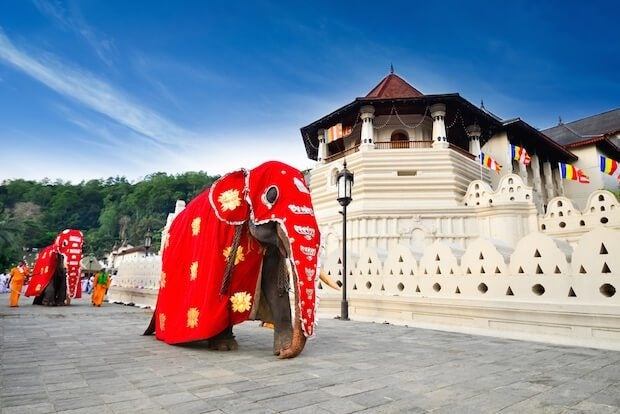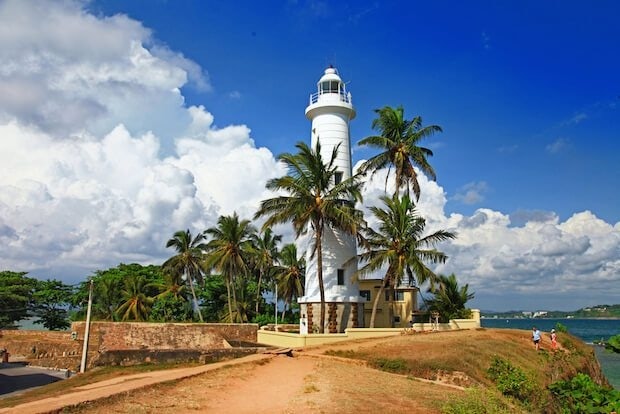
Sri Lanka is seeing massive growth in its Chinese tourist numbers. (Shutterstock)
The Members’ Stand at the Galle Cricket Club is an unexpected venue to encounter Chinese tourists. But at 10 a.m. on August 12, six Chinese girls took their seats for the start of the first test match between Sri Lanka and India. Evidently not cricket fans, they took plenty of smartphone photos, stayed an hour, and then departed. Their local guide was waiting outside the gate.
It is easy to wonder why those six vacationers spent time watching an unfamiliar game. The answer lies in the experiential curiosity for which Chinese tourists are becoming renowned. The southern city of Galle was saying goodbye to Kumar Sangakkara, who was playing his penultimate international match. A cricket legend and national hero, Sangakkara is described by the Sri Lanka Tourism Board as the nation’s “most impactful tourism brand ambassador.” Those six Chinese travelers were curious—and prepared to pay LKR 750 (RMB36)—to discover what the fuss was about, and to enjoy a unique “travel moment” to which we all aspire, even if not initially appreciating its value.
Travel providers and hoteliers worldwide are learning fast that Chinese tourists are hungry for original, firsthand experiences. And it is in places such as the teardrop-shaped island of Sri Lanka off the southeast coast of India where the growing diversity in outbound Chinese tourism is evident. Sri Lanka’s spectrum of discovery ranges from pristine coastlines and ancient ruins to wildlife safaris and offshore whale watching, and from gemstone shopping to highland tea plantations reminiscent of Hangzhou. It is attracting visitors from across China’s emerging outbound spectrum, from backpackers to business travelers to luxury mavens. And this is likely just the beginning.
Aggressive Tourism Promotion#
Chinese tourism to Sri Lanka is on an upward curve. In the first seven months of 2015, China was Sri Lanka’s second-largest tourism source market, after India. From January-July 2015, Sri Lanka received 119,705 arrivals from China—up 77.6 percent year-on-year—compared to 170,134 from India, according to the Sri Lanka Tourism Development Authority. Sri Lanka is targeting 225,000 Chinese arrivals this year, compared to just 51,704 in 2013, and 12,234 in 2010.
Aggressive tourism promotion underpins this sharp growth. The Sri Lankan government has prioritized tourism as a revenue-generating sector to help rebuild the economy after three decades of civil war, which ended in 2009. China is the premier target market. In 2013, the Sri Lanka Tourism Promotion Bureau sponsored subway station billboards in Beijing, a radio ad campaign in Shanghai and branded buses in Beijing, Shanghai, Chengdu, and Guangzhou. In 2014, it facilitated a TV crew from China’s Travel Channel, which broadcast 2,500 ads and over 500 minutes of programming dedicated to Sri Lanka.
This summer, Sri Lanka Tourism partnered with China’s state news agency Xinhua to facilitate destination marketing—using the "One island, thousand treasures" theme—via the internet, mobile, indoor, and outdoor screens at airports, hotels, and social media. It worked with the Sichuan government to increase weekly flights from Chengdu from three to five per week, and teamed up with Shanghai Tourism to offer Chinese kids a chance to visit the ruins at Polonnaruwa, which are featured in Disney’s Monkey Kingdom movie.
Sri Lanka is also targeting growth in its cruise market—a fast-developing niche sector in Asia, which cruise industry executives are betting will be driven by expansion in Chinese cruising. A proposed new cruise terminal is awaiting government approval, and Sri Lanka is targeting 60,000 passenger arrivals in 2015 and 100,000 in 2016.
Setting Sights on the South Coast#
An August 2015 report on Sri Lanka’s economy by the World Economic Forum predicted GDP growth of 7 percent this year, and noted the “Sri Lankan government has done a great job of promoting and orchestrating the travel sector.” Infrastructure upgrades are critical to its tourism strategy, and visitors can now speed along the Southern Expressway from Colombo to Galle and the South Coast, the island’s most developed tourism region.
Here, in the popular coastal village of Unwatuna, I met two young entrepreneurs—one Sri Lankan and one Malaysian—who renovate private homes for renting to visiting families and small groups. Both noted that Chinese tourists, booking via Airbnb, are among their regular clients. “They appreciate the closeness to Galle, and they can drive along the coast to places like Mirissa for whale watching,” one of the owners commented.
Down on the Unwatuna beach front, I spoke with three restaurant owners. They all told me that the previously strong Russian inbound market had dropped significantly this year, but that an increased volume of Chinese holidaymakers was evident. They were concerned, however, about their sliding revenues. “The Chinese don’t sit and drink like the Russians or Europeans. They just like to eat good seafood,” said one of the owners. Indeed, during evening visits to Unawatuna’s Lucky Tuna restaurant, young Chinese travelers crowded around the seafood station choosing their catch to be barbecued.
While independent travelers exert a growing influence, wholesale agents dominate Sri Lanka’s tourism market and direct the flow of visitors around the country, notes the 2015 Sri Lanka Country Report, published by Horwath HTL. The Chinese package tour market is heavily in evidence in the Galle Fort district. Overlooking the bay, the pretty walled fort was built by the Portuguese in the late 16th century, and later fortified by the Dutch.
Today, Galle Fort’s fine heritage buildings have been converted into design hotels, smart restaurants, locally inspired homeware stores and jewelry boutiques selling Sri Lanka’s cherished gemstones, particularly rubies, emeralds, and sapphires. All are popular with Chinese travelers. Nearby, the delightful Sun House hotel, a smart eight-room boutique hotel housed in a whitewashed colonial building once owned by a Scottish spice merchant, reported a healthy influx of Chinese guests in 2015.
I entered the Dutch Reformed Church, dating from 1755, at the same time as a Chinese coach group. After a short tour—and an attempt by three tourists to play the ancient church organ in the pulpit—the group moved on to the Fort ramparts, Galle’s most postcard-perfect spot for selfies and “wefies" with the lighthouse and ocean as a backdrop.

Sri Lanka's Galle Fort. (Shutterstock)
Emerging Colombo Chic#
In Sri Lanka’s fast-changing capital, Colombo, two Chinese businessmen are sipping tea in a seafront lounge of the Galle Face Hotel, while a family from Beijing has arrived in the lobby with an impressive haul of suitcases. Colombo is undergoing a major hospitality overhaul, and this iconic landmark, built in 1864 as one of Asia’s “grand hotels,” has just completed extensive renovations. The stellar guest list ranges from Richard Nixon, Cole Porter, and Pope John Paul II to Indira Gandhi, Scarlett Johansson, and Queen Ingrid of Denmark. It seems only a matter of time before Chinese VIPs and celebrities are added to the leather-bound guest book.
Further along the seafront, Grand Hyatt Colombo and Sheraton Colombo are due to open in 2016, while Shangri-La Colombo is slated for 2017. Macau-style “integrated resorts” are also taking shape, including local operator John Keels’ Cinnamon Life development. Though largely targeted at the Indian market, they are expected to attract high volumes of Chinese visitors, although plans to incorporate casinos were blocked by the government.
At the end of my trip, the journey to Colombo airport was wet, very wet. With the rainy season in its early throes, lashing rain made driving hazardous. I entered the airport alongside five backpackers from Guangdong. Clearly anticipating a drenching, they were dressed from head to foot in heavy-duty rain gear, the kind you would wear to hike a Nepalese mountain. Their backpacks, too, were protected with bright, waterproof covers.
In the check-in line, they swapped smartphone photos, notably the sacred rock of Siguriya and the UNESCO World Heritage-listed ruins at Pollonaruwa. I asked what they thought of Sri Lanka. “Beyond our expectations,” they beamed. And what response had they received from friends and family to the photos uploaded on social media. “Everyone is surprised. They didn’t know Sri Lanka before. Now many also want to come.” It was the kind of response that tourism board executives the world over dream of hearing.
Gary Bowerman is Founding Partner of Scribes of the Orient, and author of The New Chinese Traveler: Business Opportunities from the Chinese Travel Revolution.